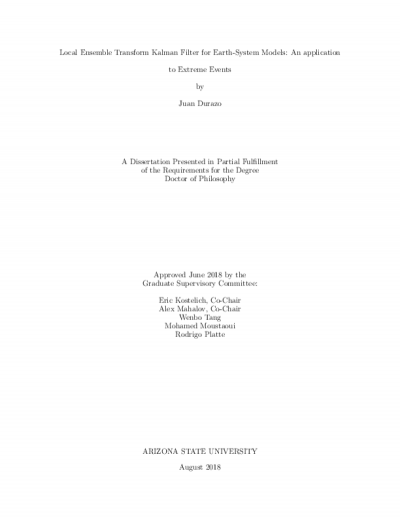Modeling Brain Cancer Progression Using Reaction-Diffusion Equations with Minimal Parameters

Description
A description of numerical and analytical work pertaining to models that describe the growth and progression of glioblastoma multiforme (GBM), an aggressive form of primary brain cancer. Two reaction-diffusion models are used: the Fisher-Kolmogorov-Petrovsky-Piskunov equation and a 2-population model that divides the tumor into actively proliferating and quiescent (or necrotic) cells. The numerical portion of this work (chapter 2) focuses on simulating GBM expansion in patients undergoing treatment for recurrence of tumor following initial surgery. The models are simulated on 3-dimensional brain geometries derived from magnetic resonance imaging (MRI) scans provided by the Barrow Neurological Institute. The study consists of 17 clinical time intervals across 10 patients that have been followed in detail, each of whom shows significant progression of tumor over a period of 1 to 3 months on sequential follow up scans. A Taguchi sampling design is implemented to estimate the variability of the predicted tumors to using 144 different choices of model parameters. In 9 cases, model parameters can be identified such that the simulated tumor contains at least 40 percent of the volume of the observed tumor. In the analytical portion of the paper (chapters 3 and 4), a positively invariant region for our 2-population model is identified. Then, a rigorous derivation of the critical patch size associated with the model is performed. The critical patch (KISS) size is the minimum habitat size needed for a population to survive in a region. Habitats larger than the critical patch size allow a population to persist, while smaller habitats lead to extinction. The critical patch size of the 2-population model is consistent with that of the Fisher-Kolmogorov-Petrovsky-Piskunov equation, one of the first reaction-diffusion models proposed for GBM. The critical patch size may indicate that GBM tumors have a minimum size depending on the location in the brain. A theoretical relationship between the size of a GBM tumor at steady-state and its maximum cell density is also derived, which has potential applications for patient-specific parameter estimation based on magnetic resonance imaging data.
Date Created
The date the item was original created (prior to any relationship with the ASU Digital Repositories.)
2023
Agent
- Author (aut): Harris, Duane C.
- Thesis advisor (ths): Kuang, Yang
- Thesis advisor (ths): Kostelich, Eric J.
- Committee member: Preul, Mark C.
- Committee member: Crook, Sharon
- Committee member: Gardner, Carl
- Publisher (pbl): Arizona State University


